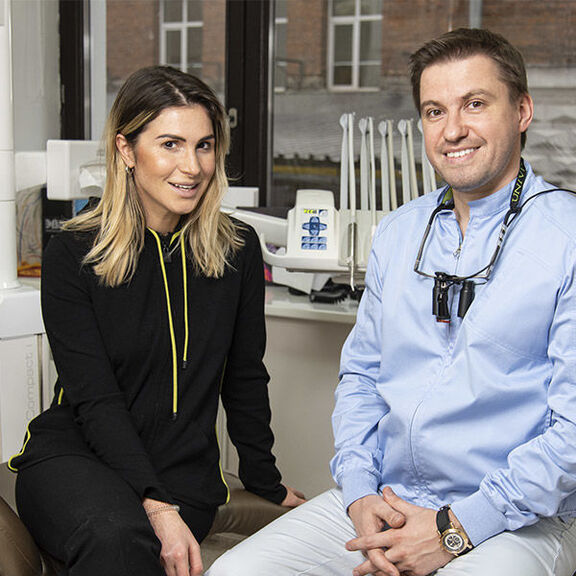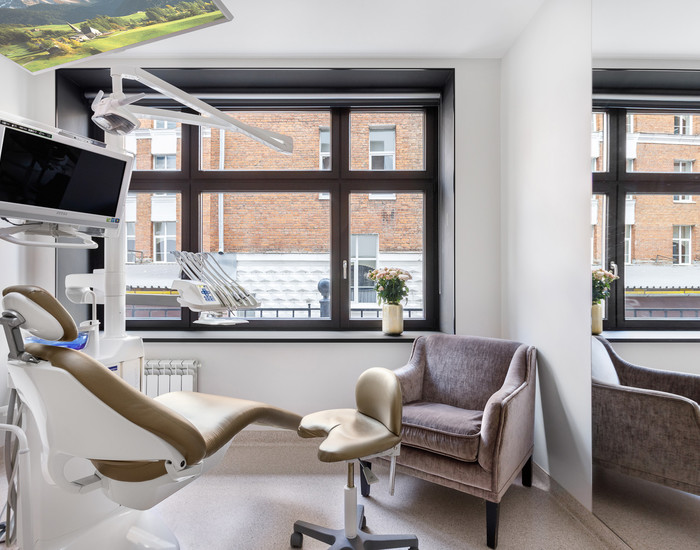The jawbone deteriorates for various reasons: injuries, inflammatory processes, long-term absence of teeth, and the resulting reduction in the load on the jaw. But lack of bone tissue is a contraindication to implantation: implants have nowhere to be implanted. In this case, bone augmentation is required.
How we can be
useful to you:
Veneers Without Grinding
Pediatric dentistry
Correction of bite
Implantation and crowns
What is bone grafting

This is a surgery, also called osteoplasty, to increase the bone volume of the upper or lower jaw. It allows the implant, a metal post that is implanted into the jaw and acts as an artificial root for a dental crown, to be securely anchored in place, providing the necessary support for bridges or dentures.
When a tooth is missing, the bone tissue around where the tooth used to be gradually erodes. This process is called resorption. The space that was occupied by the removed roots is overgrown by gum tissue, which grows much faster than the jawbone. Even if a little time has passed since the loss of the tooth, there may be difficulties with the installation of the implant - it will have nowhere to implant. In this case, bone grafting, possibly including the use of synthetic materials, is recommended.
After implantation, artificial roots loaded with crowns will provide the level of stress on the bone that is necessary to keep it from resorbing.
Varieties of bone grafting
The operation is performed in several ways. The optimal option is chosen by the doctor, based on the individual characteristics of the patient. Therefore, before bone augmentation, a diagnostic examination, which may require a root canal assessment, must be carried out.
According to the source of material for osteoplasty, the variety of methods is divided into two groups:
- xenotransplantation - material obtained from animals is used;
- autotransplantation - the patient's own material is used, taken in a small amount from another area, which significantly reduces the risk of rejection.
Directed bone regeneration
This type of osteoplasty is the most common. It is used if the resorption of the jawbone is insignificant. It can be combined with other techniques. Physician:
- installs the implant;
- places bone material around it;
- closes the area with a membrane of collagen, which resorbs over time.
The implant engraftment goes in parallel with the build-up of the missing bone volume. The crown can be placed after 4-6 months.
Advantage - time saving. Minus - the method is ineffective in case of significant bone deficiency (atrophy).
Bone block transplantation
This method is rarely used, usually if the patient is completely missing their own bone in the area where the implant is to be placed.
Physician:
- extracts the required amount of bone from the patient's chin or the area behind the wisdom tooth;
- Drills holes in the resulting block to improve blood flow and increase the likelihood of implant engraftment;
- fixes the block in the defect area with titanium screws;
- fills the space with bone chips;
- covers the area of exposure with a collagen membrane.
It takes 6-12 months to regain the proper bone volume.
The advantage is that implants can be placed even if there is a complete absence of bone.
Disadvantages - long and expensive surgery, risk of implant rejection.
Splitting of the bone ridge

It is used if you need to increase the width of the bone. To do this, the surgeon, often operating under general anesthesia, performs the following steps:
- cuts through the soft tissue of the gum;
- performs a ridge cut in the longitudinal direction;
- expands the alveolar process by inserting drills of different diameters into the alveolar process;
- forms a cavity into which the implants are placed, then they are closed with plugs;
- fills the empty space with osteoplastic material.
Advantages - osteoplasty is performed at the same time as implantation, 2-3 implants can be placed at the same time.
Disadvantages - bone thickness must be at least certain values.
Sinus elevator
Used if you need to increase the volume of bone in the upper jaw in the maxillary sinus area. Surgeon, who is often a specialist in this type of surgery, performs the following steps:
- allows access to the floor of the maxillary sinus;
- raises the bottom using a special tool;
- puts osteomaterial in the empty space.
The advantage is that it allows you to significantly increase the bone volume of the upper jaw.
The disadvantage is that it requires a highly skilled surgeon.
When bone grafting of a tooth is needed and what it provides
The main causes of bone loss are tooth loss due to injury or disease and age-related changes. Osteoplasty can restore the jaw after damage, increase the volume of the jawbone and protect the overall health of the patient. With its help, unpleasant consequences such as facial asymmetry can be avoided.
Dentists recommend filling the hole with bone material after tooth extraction. This helps to prevent the loss of bone mass.
Stages of the operation
Before osteoplasty is mandatory:
- dental consultation;
- diagnosis;
- preparatory measures - it is necessary to cure diseases that exist in the oral cavity, sanitation.
The surgery is carefully planned. Computed tomography provides a three-dimensional scan of the jaw and creates an accurate computer model for the doctor to work with.
After that, bone grafting is performed. The operation is carried out in several stages:
- anesthesia - depending on the individual characteristics of the patient and his wishes, local anesthesia, general anesthesia or sedation are used;
- preparation of the area of the operation - the surgeon dissects the gum and opens access to the place where he will perform manipulations;
- directly plastic - osteomaterial grafting according to the chosen method;
- membrane installation - if required by the protocol;
- suturing - the surgeon sutures the gum.
Bone Grafting
-
Title
Price
-
Bone Grafting
3 460 AED
-
Alveolar Ridge Bone Grafting Using Bio-Oss (Material Not Included), Complexity Level I (Includes all necessary imaging and local anesthesia)
3 460 AED
-
Alveolar Ridge Bone Grafting Using Bio-Oss (Material Not Included), Complexity Level II (Includes all necessary imaging and local anesthesia)
7 160 AED
Indications
The main indications for bone grafting are:
- Long-term absence of teeth, which provokes atrophy and reduction in the volume of tubular bone; tooth loss due to trauma or difficult extraction - this leads to bone loss in the width and height of the alveolar ridge in the area of the tooth roots;
- anatomical features of the jaw - for example, it is not possible to fix implants immediately after tooth extraction because of a thin alveolar ridge on the lower jaw or a large maxillary sinus;
- Bone destruction caused by periodontitis or periodontal disease.
Contraindications
Absolute contraindications in which surgery is not possible are:
- blood disorders;
- immune system dysfunction;
- cancer.
Relative contraindications that allow osteoplasty to be performed after the problem has been resolved are:
- inflammatory processes in the mouth area;
- ENT pathology;
- cardiovascular disease;
- diabetes mellitus in decompensation.
To make you healthy,
happy and successful!
will help you with this
Advantages of performing bone augmentation in the jaw

Osteoplasty is the only way to stop the destruction of the jawbone. Often, implants cannot be performed without it, as the surgeon will not be able to place metal posts in the jaw or they will not hold in the jaw. After bone grafting, the artificial roots will last for decades.
Also, the surgery allows:
- to regain the comfort of communication;
- to regain the ability to chew your food properly;
- prevent the risk of serious complications.
Rehabilitation and care

The doctor will definitely give recommendations for recovery after osteoplasty, based on the individual characteristics of the patient and the specifics of the surgery. Usually in the first few days after osteoplasty you will need:
- Apply ice to the affected area;
- take medications prescribed by a doctor: anti-inflammatory, antimicrobial;
- avoid significant physical exertion;
- Do not consume excessively hot, as well as spicy and very salty food, hard foods;
- Brush your teeth as gently as possible, avoiding the post-operative wound.
The body's natural reaction to bone grafting can be:
- bloody discharge from the postoperative wound;
- swelling, lividity in the affected area;
- elevated body temperature;
- headache, dry throat, facial muscle tension.
All this is observed for a few days. If the above symptoms do not go away 2-4 days after osteoplastic surgery, you should inform your doctor.
It is also necessary to consult a doctor in case of a sharp rise in temperature, fever, increased swelling, any deterioration of health.
Contact AESTHET Dentistry! This is a modern dental center that provides services at a high professional level. Experienced surgeons solve aesthetic and functional problems caused by bone resorption. They perform osteoplasty necessary for further implantation.
Prices are listed on the website. Please contact our managers to clarify this information.
Evaluate the amazing
results of our clients:
FAQ
Literature sources
- Albee FH: An experimental study of bone growth and the spinal bone transplant. JAMA 60:1044–1049, 1913
- Giannoudis PV, Dinopoulos H, Tsiridis E. Bone substitutes: an update. Injury. 2005; 36(Suppl 3): S20-S27.
- Gazdag, AR, Lane JM, Glaser D, et al: Alternatives to autoge- nous bone graft: efficacy and indications. J Am Acad Orthop Surg 3:1–8, 1995
Our clinics:
Clinic in Dubai
Resident part, Building 10
Clinic in Moscow
metro Chistye prudy
Clinic in Moscow (Barvikha)
Shopping center "Dream House" 3rd floor















































_700x550_ac7.jpg)






